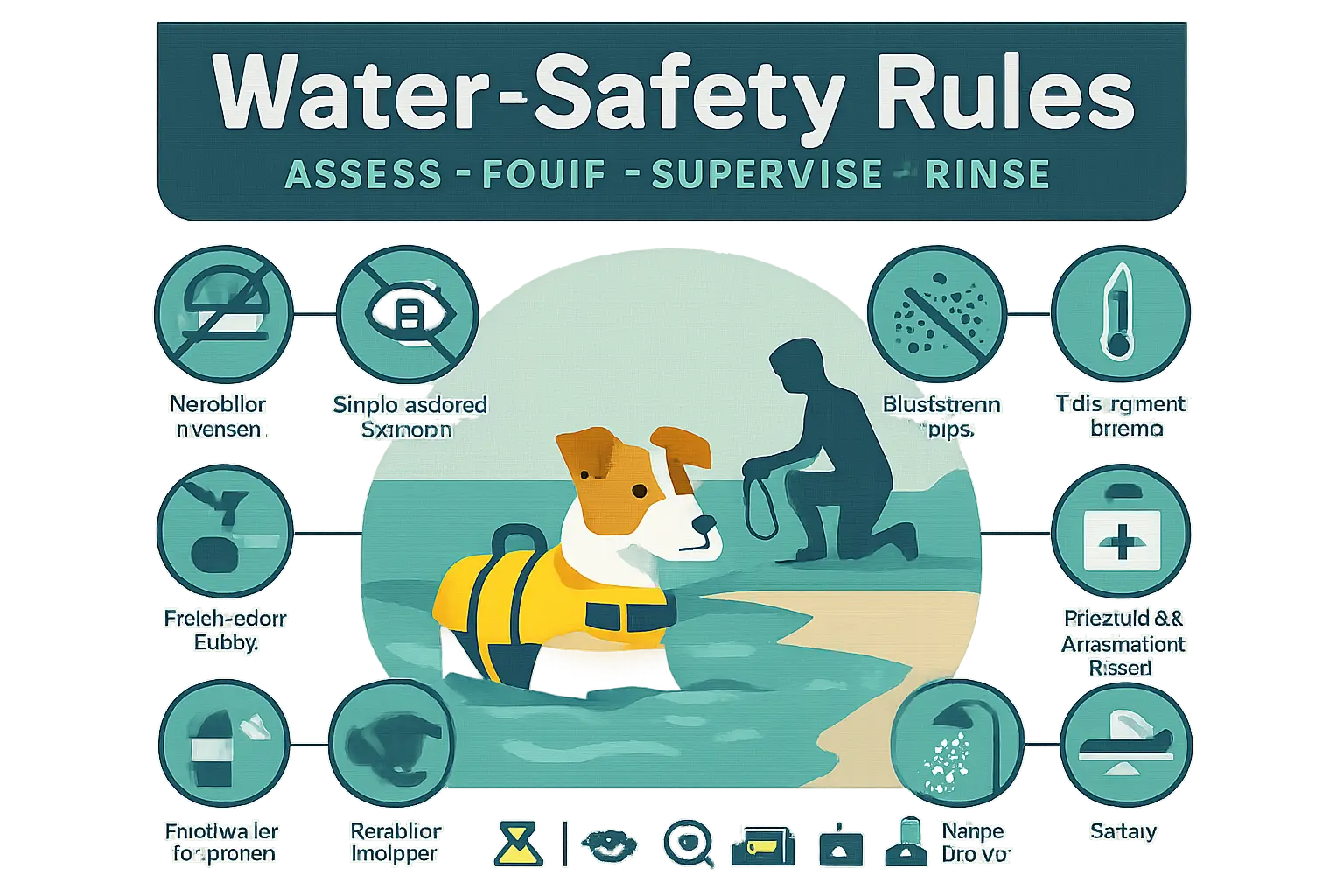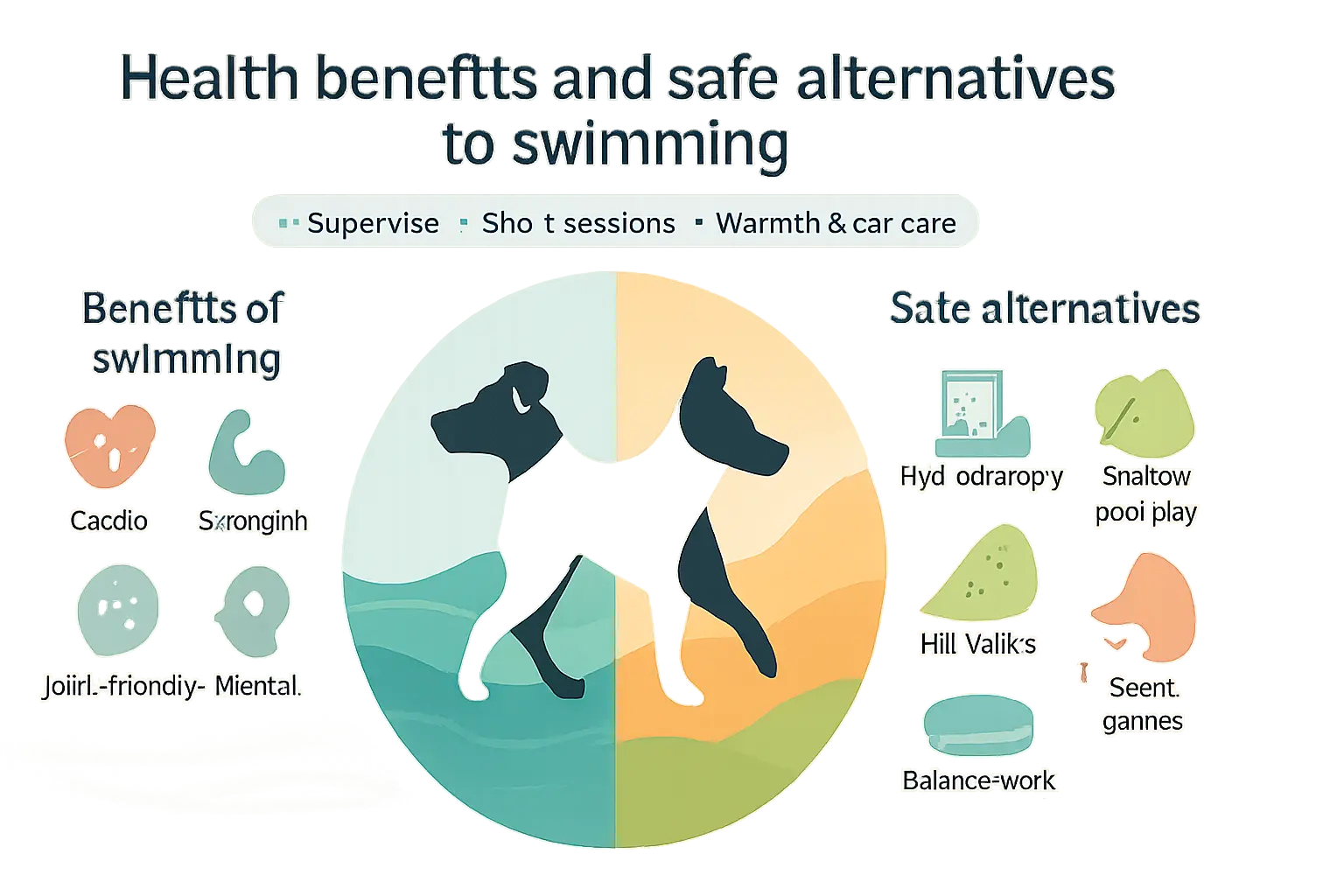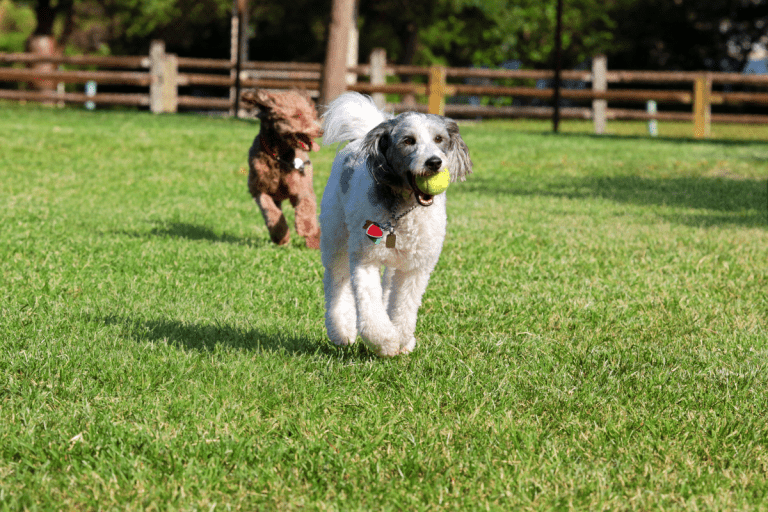Can (and Should) Jack Russell Terriers Swim?
Last Updated on August 28, 2025
Can (and Should) Jack Russell Terriers Swim? Many can, but not all should. Ability varies with build, fitness, confidence, and water conditions. Short legs and heavy heads can tax endurance. Prey drive may push a terrier into deep water or strong currents. Without preparation, risks include fatigue, hypothermia, and ear infections.
Below, owners find a clear path to safe water fun. Topics include shallow-water starts, recall and exit cues, and choosing a life jacket. The guide also flags health limits and environmental hazards like algae, tides, and murky pools. When swimming isn’t wise, options such as hydrotherapy and portable dog pools keep activity safe. Keep reading for practical steps, gear checks, and rapid-response tips.
Can Jack Russells Swim?
Many Jack Russell Terriers can swim, but ability varies widely between individuals. Their natural dog-paddle motion and high energy help some reach the shore. However, short legs, dense bodies, and heavy heads can make sustained swimming tiring. Water confidence and endurance depend on prior exposure, fitness, and the conditions.
Owners should not assume every Jack Russell will self-rescue. Supervision and a properly fitted canine life jacket matter for open water, strong currents, or deep pools. Start with shallow, calm water and short sessions. Watch for paddling that becomes frantic, failing to breathe rhythmically, or bobbing low in the water—signs of fatigue.
Protecting a Jack Russell’s safety also includes preventing hypothermia and ear problems after swims. Consider gradual introductions and controlled practice around a pool or calm lake before allowing unsupervised access. For safe at-home practice, portable dog pools offer gentle, shallow learning environments like the 10-refreshing-puncture-proof-dog-pools. If uncertainty remains, consult a veterinarian or a certified trainer before extended water activities.
Natural instincts and breed traits that influence swimming
Jack Russells descend from terrier lines bred for hunting and agility, not specifically for water work. Their prey drive encourages chasing and diving after small animals, which can push a dog into water unexpectedly. Strong prey motivation can make a dog brave but also reckless around currents and drop-offs.
Physical traits shape swimming mechanics. A deep chest improves buoyancy; a heavy head or short legs reduce propulsion and increase energy use. Coat type affects insulation and water absorption; a wetter, heavier coat saps warmth and adds weight. Tail length and carriage act as a rudder for steering; docked tails reduce that control.
Behavioral instincts also matter. High drive and confidence speed learning when paired with positive reinforcement. Conversely, a nervous Jack Russell may panic in unfamiliar water. To reduce risk, teach recall and water exit cues on land first. For ear protection and after-swim care, owners can learn more about preventing swimmer’s ear with products discussed in dog ear plugs for swimming.
How age, temperament and prior exposure change skill
Puppies often show curiosity and can learn to swim with short, supervised sessions. Young dogs build muscle and stamina faster than seniors. Older Jack Russells may lose strength, have arthritis, or tire quickly, so owners should limit sessions and avoid deep water.
Temperament influences approach and progress. Bold, food-motivated dogs respond well to stepwise training. Anxious dogs need slower exposure, predictable routines, and plenty of praise. Use shallow water, a calm handler, and high-value rewards to build positive associations.
Prior exposure creates skill and confidence. Repeated, brief practice improves technique and reduces panic. Introduce safe exit points, teach a reliable “exit” cue, and use a harness for controlled support during early swims. Monitor water temperature and fatigue signs closely. For dogs with travel or separation anxiety that affects water confidence, behavior-focused strategies may help; see strategies in 9-natural-ways-to-remedy-your-dogs-travel-anxiety.
Factors that make a Jack Russell a good or poor swimmer
Can (and Should) Jack Russell Terriers Swim? The short answer depends on a mix of anatomy, conditioning and context. Some Jack Russells take to water instinctively and paddle effectively. Others struggle because of build, health or fright. Owners should evaluate muscle tone, body fat, coat density and prior exposure before allowing water play. Strong hindquarters and a balanced, compact frame help a terrier stay level while swimming. Excess weight or a heavy chest can sink the dog’s rear end, forcing a stressed, inefficient swim. Age matters: puppies lack coordination and older dogs show declining endurance and joint issues. Training builds confidence and technique, while fear or panic worsens drowning risk.
Access and water type also shape outcomes. Calm pools suit a beginner; fast-moving rivers do not. For controlled backyard options, owners can consider safe shallow pools and pet-specific gear. A list of suitable small dog pools and durable options appears at 10 Refreshing Puncture-Proof Dog Pools, which helps owners choose appropriate play environments.
Body shape, size and conditioning
Jack Russells vary in size and conformation. Some have a lean, athletic build with strong hind legs and a straight topline. Those traits help the dog maintain a horizontal posture while paddling. Dogs with deep chests or short legs, however, appear lower in the water and must work harder to keep their heads above the surface. Muscle mass and conditioning determine endurance more than raw breed label. Regular swimming sessions increase stamina and improve propulsion, but owners must progress slowly.
A training plan should begin with short, supervised entries in shallow water. Use positive reinforcement and gradual distance increases. Building core strength on land—hill repeats, controlled fetch, and structured play—transfers to better stroke efficiency. Compare how other breeds swim to set realistic expectations; for example, breeds with longer limbs often cover water with fewer strokes. For a reference on how different breeds manage water, see Can Dobermans Swim?
Health issues that restrict water activity
Certain medical conditions make swimming unsafe or unwise for a Jack Russell. Joint disease, hip dysplasia, cruciate injuries and severe arthritis reduce propulsion and increase exhaustion risk. Heart and respiratory disease limit oxygen delivery and can turn a short swim into a dangerous event. Dogs with neurologic disorders may lose coordination while afloat. Ear infections and ruptured eardrums worsen with water exposure, especially in dogs prone to otitis.
Puppies under vaccination schedules should avoid communal waters where parasites or bacteria circulate. Pregnant bitches, dogs recovering from surgery, and those on heavy medications need veterinary clearance. If the dog has a history of collapsing episodes or epilepsy, do not permit unsupervised water activity. For breed-specific cautions about brachycephalic and small-faced breeds, which can face breathing limitations, review examples like Can Shih Tzus Swim?
Environmental factors: water type, temperature and current
Environment dictates safety more than most owners expect. Saltwater, waves and strong currents demand experienced swimmers and life jackets. Cold water reduces muscle function and causes rapid hypothermia in small dogs. Chlorinated pools can irritate eyes and skin when exposure is prolonged. Stagnant water or algae blooms contain bacteria and toxins that cause vomiting, seizures or death.
Visibility matters: murky water hides hazards like drop-offs, submerged debris, or sudden depth changes. Wind-driven chop and surf overwhelm a small terrier’s paddling. Always test water temperature and current before entry. Use a canine life jacket for open water, and secure a short training tether for early lessons. Consider ear protection in freshwater and pool environments; products and recommendations are available at Dog Ear Plugs for Swimming. If uncertainty persists, consult a veterinarian before introducing a Jack Russell to open water.
Essential water-safety rules for owners

Owners should treat water outings with the same planning they give car trips. Assess the Jack Russell’s swim ability before allowing free access. Short sessions in calm, shallow water build confidence. Always pack basic safety gear: a properly fitted life jacket, a towel, fresh water, and a canine first-aid kit. Keep outings short in cold water to prevent hypothermia.
Check local rules and conditions before entering lakes, rivers, or the ocean. Remove collars that can catch on obstacles during swims. Make a habit of rinsing off chlorine, salt, and algae after each session to protect skin and eyes. For guidance on packing sensible gear for travel and outdoor trips, see essential dog travel tips and gear for road trips.
Teach basic water recall and an exit cue on dry land, then practice at the shoreline. Avoid forced entry; pressure can make a dog fearful of water. Finally, never let alcohol, crowds, or distractions reduce supervision quality.
When a life jacket is necessary and how to pick one
Life jackets become necessary when conditions exceed the dog’s comfort or ability. Use a PFD for boating, strong currents, cold water, inexperienced swimmers, seniors, puppies, or dogs recovering from illness. A jacket gives buoyancy and makes rescue quicker.
Choose a jacket with a secure fit and a handle on the back. Look for high-visibility colors and reflective trim. Adjustable straps prevent the jacket from riding up, while a snug neck area keeps the head above water. Check buoyancy recommendations for the dog’s weight and chest girth rather than breed alone.
Test the jacket in shallow water before trusting it in open water. Confirm it allows the dog to paddle naturally and to put its nose above the surface. Consider models with leg straps to reduce rotation. For related protective gear options, owners can review resources like waterproof dog coats with underbelly protection.
Common water dangers (algae, tides, pools, boats) and how to avoid them
Blue-green algae poses a severe poisoning risk. Avoid any water with green scum, foam, or dead fish. Keep Jack Russells from drinking from or swimming in suspicious water. If exposure occurs, seek veterinary care immediately.
Tides and rip currents can overwhelm small dogs. Check tide charts and local signage before entering coastal areas. Teach dogs to swim parallel to a rip to escape it and to head for a known exit point. On rivers, watch for undertows and fast-moving flow near bends and bridges.
Pools present chlorine irritation, sharp drains, and steep sides. Ensure safe egress with ramps or stairs and always supervise pool time. A selection of robust backyard pools can reduce puncture risks; see options at 10 refreshing puncture-proof dog pools. On boats, use a PFD, keep dogs away from propellers, secure them while underway, and avoid allowing them to jump off without a clear plan for retrieval.
Supervising, exit strategies and never-leave rules
Close, active supervision prevents most water incidents. Assign a single person to watch the dog when multiple people are present. Never leave a Jack Russell unattended near any body of water, including fenced pools and shorelines.
Teach a clear exit cue and practice it from multiple locations. Train the dog to approach ramps, ladders, or a specific shoreline spot on command. Use short, frequent drills that reward quick exits. Carry a lightweight throwable float and a leash for emergency retrieval.
Plan transport and post-swim warming. Secure the dog in a vehicle or crate during transit, and dry the dog promptly to avoid chills. For techniques to keep a dog secure during travel and transitions, consult practical guidance such as how to secure a dog in car with leash. Owners should also prepare an emergency vet contact and practice a rescue lift before heading into open water.
Step-by-step: Teaching a Jack Russell to swim
Teaching a Jack Russell to swim requires a clear progression and consistent supervision. Start with short, calm sessions and increase duration only after the dog shows comfort. A typical sequence: land-based obedience, shallow water exploration, supported swims, independent short swims, and then longer swims with rest breaks. Check health first: ensure the dog is fit, not arthritic, and cleared by a vet if any concerns exist.
Use a properly fitted canine life jacket for every water session until the dog reliably paddles and exits on its own. Keep flotation snug but not restrictive. Pay attention to water temperature; cold water drains energy quickly. Bring fresh water and towel to prevent the dog from ingesting too much pool or lake water.
Time each session and watch for fatigue signs: slowing paddling, low head carriage, or frantic movements. End sessions while confidence is high. For gear, transport and outing prep, consult practical packing and equipment advice in essential dog travel tips and gear for road trips. A short, supervised practice session once or twice weekly builds skill without overtiring the dog. If uncertainty remains, seek a professional trainer experienced with waterwork.
Preparing the dog and choosing a safe location
Preparation reduces risk and speeds learning. Have the dog wear a well-fitting life jacket during initial swims. Inspect the chosen location for a gentle slope or ramp for easy entry and exit. Avoid steep banks, strong currents, rip tides, or murky water that hides hazards.
Prefer calm, shallow spots: small ponds, protected bays, or a dog-safe pool. Portable dog pools provide a controlled, low-risk place to practice first strokes; consider a puncture-proof model designed for dogs. Check water quality—no heavy algae, chemical smells, or sharp debris. Keep leash and a long line on hand to guide the dog and prevent sudden bolting.
Warm up the dog on land with a short play session and basic obedience cues. Inspect ears, paws, and nails before entry to avoid infections and snagging. If the dog has heart or respiratory issues, skip open water and consult a vet. For pool options and low-risk water gear, see 10 refreshing puncture-proof dog pools.
First introductions, supported swims and building confidence
First water introductions should be calm and positive. Lead the dog into shallow water while keeping a loose hold on the life jacket handle. Use high-value treats and a favorite toy as incentives. Allow the dog to stand and paddle before offering any support.
During the first supported swims, support the dog under the belly and chest so the legs can paddle naturally. Keep hands just under the body—never lift the dog by the collar or thrust it forward. Start with 10–30 second assisted swims, then rest on land and reward. Gradually lengthen assisted swims when paddling looks steady and relaxed.
Encourage independent swimming by reducing hand support slowly. Use a floating target or toy at a short distance to motivate a swim toward a confident exit. Watch for inefficient paddling or head dipping; these signs mean more support or shorter sessions. Protect ears after sessions according to water-care advice at dog ear plugs for swimming.
Commands, recall and exit drills to reinforce safety
Strong verbal and visual cues save lives in water. Teach simple commands on land first: a clear recall (“come”), a shore exit cue (“out” or “exit”), and “wait” for controlled entries. Use a long line to blend land drills with water practice.
Run repeatable exit drills: have a helper stand at the known exit and reward the dog for swimming straight to that person. Practice the recall from short distances in open water, slowly increasing distance. Reinforce exits with treats and a calm, upbeat voice.
Use a life jacket with a handle to assist an emergency lift. Simulate safe exits from docks or boats and practice attaching a leash immediately after the dog leaves water. For guidance on securing a dog at transitions like car exits, review how to secure a dog in car with leash. If the dog consistently ignores recall, stop open-water swims until training improves. Consider professional lessons for stubborn recall issues.
Troubleshooting training problems and managing fear

When a Jack Russell resists water, trainers should look beyond stubbornness. Puppies and adults react for many reasons: lack of exposure, past negative experiences, low confidence, or physical discomfort. Start by breaking the goal into tiny steps. Use a secured, shallow area and keep sessions under five minutes. Substitute high-value rewards immediately after calm behavior to create a positive association.
Gear helps. A properly fitted life jacket reduces sinking anxiety and lets the dog learn the stroke without panic. Rotate toys and short swims to maintain interest. Remain consistent with cues and timing; confusing signals reset progress. If progress stalls despite regular, gentle practice, reassess the environment, reward choice, and session length.
For broader preparation and safety planning before water outings, consult resources on travel and gear for dogs like essential dog travel tips and gear for road trips. That guidance can help owners choose appropriate equipment and plan gradual exposure without overwhelming the dog.
Reading stress signals and when to pause lessons
Recognizing stress signals lets trainers stop before fear escalates. Watch for rapid panting, lip licking, yawning, whale eyes, tucked tail, trembling, or repeated attempts to flee. A sudden freeze or refusal to take treats signals a high threshold and a need to back off.
Pause immediately when those signs appear. Return to an easier, previously successful step and reward small calm responses. Shorter, more frequent sessions work better than long ones. Track each session’s end on a positive note, even if it means stepping back to leash games or dry-land play. If anxiety reduces, slowly reintroduce water cues over several sessions.
For owners who notice broader travel or separation anxiety while exposing a dog to new situations, the guide 9 natural ways to remedy your dog’s travel anxiety offers complementary tactics to lower baseline stress.
Techniques to overcome water anxiety
Use gradual desensitization paired with counterconditioning. Begin at the shoreline or pool edge with the dog on a non-slip surface. Reward approach and sniffing. Progress to wading at knee depth, then to deeper water over multiple short sessions. Keep voice tone calm and movements predictable.
A supportive harness lets an owner guide swimming without lifting, while a life vest maintains buoyancy and confidence. Use floating toys to focus attention away from fear. Reinforce every calm paddle with high-value treats and praise. If the dog drinks too much water, stop and dry off; repeated gulping often signals panic.
Portable training pools can help owners control depth and temperature. For ideas on safe, backyard swim gear, see 10 refreshing puncture-proof dog pools.
When to call a trainer or veterinarian
If gradual training fails or the dog shows physical or extreme behavioral symptoms, involve professionals. Call a veterinarian when signs suggest pain or illness: persistent ear shaking, head tilting, ear discharge, coughing, vomiting, or labored breathing after near-water exposure. These symptoms can make a dog avoid swimming.
Seek a certified positive-reinforcement trainer when fear persists despite consistent, patient work. Trainers can design a stepwise program and teach owners handling techniques, threshold management, and reinforcement timing. If fear links to trauma or aggressive reactions, consult a trainer experienced with behavior modification.
When in doubt, prioritize medical evaluation first. For situations involving ear discomfort or water-related ear problems, owners can review options such as dog ear plugs for swimming and then discuss suitability with the veterinarian. Schedule a professional consult when progress stalls for several weeks or when safety becomes a concern.
Recommended equipment and aftercare
When introducing a Jack Russell to water, prioritize safety and convenience. Essential items include a properly sized life vest, a ramp or low-entry platform for easy exits, a floating leash or long line for controlled practice, and absorbent towels for fast drying. Pack an ear-cleaning solution and a parasite-check kit for after swims. Quality matters: choose durable fabrics and corrosion-resistant clips to withstand salt, sand, and chlorine.
Before heading out, confirm vaccinations and flea/tick prevention are current. Keep freshwater available so the dog avoids drinking lake or pool water. Store wet gear in a ventilated bag to prevent mildew and bacteria buildup. For a broader checklist aimed at travel and gear, see essential dog travel tips and gear for road trips. A short gear test at home helps identify fit or function issues before open water.
CTA: assemble and inspect equipment before the first swim session to reduce risk and boost confidence.
Choosing the right canine life vest and fit checks
Not all Jack Russells need a life vest, but most benefit from one during open-water introductions. Pick a vest sized for the dog’s weight and chest circumference. Look for wide belly straps, adjustable buckles, and a strong top handle for easy lifting. Bright colors and reflective trim improve visibility.
Conduct fit checks on dry land. The vest should sit snug without rubbing. You must be able to slide two fingers under the chest strap. Ensure the neck opening clears the shoulders so the head lifts easily. Test in shallow water first and watch the dog’s head position; the snout should stay above water without excessive effort. If lifting becomes necessary, a top handle lets the handler guide the dog. For guidance on safe lifting and handling techniques that pair well with vest use, consult 5 steps to safely lift a large dog into a car.
Useful accessories: ramps, buoyant toys and leashes
Ramps and steps reduce strain on joints and prevent repeated, risky jumps. Choose a non-slip surface and test the incline for confidence. Portable pet ramps work at docks, pools, and boats. For play and training, use soft, buoyant toys that float readily and remain visible at a distance. Avoid heavy or waterlogged toys that pull the dog under.
Leash choices matter. Use a floating leash or a 15–30 foot long line for controlled retrievals and gradual distance builds. Attach the leash to the life vest handle for safer control; avoid clipping to a collar when the dog is wet. Replace retractable leashes near water with fixed lines to prevent tangles. Inflatable pools and puncture-proof options make safe backyard practice; see recommendations for durable pools at 10 refreshing puncture-proof dog pools.
Post-swim care: drying, ear cleaning and parasite checks
After every swim, rinse the dog with fresh water to remove chlorine, salt, or silt. Dry thoroughly with absorbent towels and, if needed, use a hair dryer on the lowest warm setting while keeping it several inches away from the skin. Pay special attention to skin folds and the area under the collar.
Clean the ears with a vet-approved cleaner to reduce swimmer’s ear risk. Apply only solutions recommended by a veterinarian and follow label instructions. Watch for persistent head shaking, redness, foul odor, or discharge—these signs warrant a clinic visit. Check the coat for ticks, wounds, or foreign bodies and apply appropriate flea/tick prevention after aquatic outings. For advice on protecting ears during water activities, see dog ear plugs for swimming.
If the dog swallows unknown water or shows lethargy, vomiting, or difficulty breathing, contact a veterinarian immediately.
Health benefits and safe alternatives to swimming

Swimming can offer significant health gains for many breeds, and the question Can (and Should) Jack Russell Terriers Swim? often comes down to individual fitness, age and temperament. Regular, well-supervised swims provide low-impact cardiovascular work, build lean muscle, and help control weight without stressing joints. Owners should watch for fatigue, cold water, strong currents and ear infections. For dogs that enjoy water but need extra protection, gear can reduce risk and extend sessions safely. A breathable, waterproof layer and underbelly protection help small, active terriers stay warm after a dip; owners can learn more about protective options at waterproof dog coats with underbelly protection.
When swimming proves unsafe or unsuitable, safe alternatives exist that still deliver conditioning and enrichment. Choosing the right option depends on the dog’s medical history and fitness goals. A veterinarian or qualified canine physiotherapist can recommend a tailored plan that preserves the benefits of aquatic exercise without unnecessary risk.
How swimming helps fitness, joints and mental stimulation
Swimming delivers full-body aerobic work while water buoyancy reduces joint loading. For active terriers, regular swims build shoulder and hindquarter strength, improve endurance and support healthy body composition. Water lets dogs push cardiovascular limits with less impact than running on hard ground. For dogs with early arthritis or recovering from soft-tissue injuries, short, controlled swims can increase range of motion and slow muscle loss.
Beyond physical gains, swimming offers mental stimulation. New environments, water smells and retrieving toys from water engage a dog’s senses and problem-solving skills. That stimulation reduces boredom-driven behaviors common in high-energy breeds.
Owners should limit initial sessions, monitor effort, and dry ears thoroughly to cut infection risk. For guidance on protecting canine ears during water activities, see practical options at dog ear plugs for swimming. Introduce water gradually and stop at the first sign of stress or exhaustion.
Alternatives for dogs that shouldn’t swim (hydrotherapy, land exercises)
Some Jack Russell Terriers should avoid open-water swimming. Reasons include poor swimming mechanics, age, respiratory or heart conditions, and post-operative restrictions. Hydrotherapy clinics offer controlled aquatic rehabilitation through underwater treadmills and pool sessions supervised by trained therapists. Those setups reproduce the benefits of swimming with adjustable support and monitored intensity.
Land-based options also replicate cardiovascular and strength gains. Interval walking, uphill strolls, controlled leash-sprinting, balance work on wobble boards, and bodyweight core exercises increase fitness safely. Play-based activities such as flirt-pole sessions and scent games deliver high mental engagement without water. For owners who still want water play without full swimming, shallow dog pools provide supervised splash sessions and sensory enrichment; see safe, puncture-resistant choices at 10 refreshing puncture-proof dog pools.
Before starting hydrotherapy or a new exercise plan, owners should consult a veterinarian. A professional can prescribe session length, frequency and progression. For a clear next step, ask a vet about local hydrotherapy referrals and a tailored land-exercise routine.
Quick decision guide and common questions
Deciding whether a Jack Russell should swim depends on four quick checks: age, health, temperament and water conditions.
If the dog is a young puppy without full vaccinations, senior with arthritis, or has known heart or seizure problems, avoid unsupervised water activities. Temperament matters: an eager, confident dog will usually pick up swimming faster than a fearful one. Calm, shallow water and close supervision reduce risk. Introduce water gradually—let the dog wade first, then encourage gentle paddling toward the owner. Use a properly fitted canine life jacket for early sessions or when waves or currents exist.
For safe at-home water play, consider sturdy portable pools built for dogs. A low-sided, puncture-proof pool reduces panic and makes exit easy. See options for durable canine pools at 10 refreshing puncture-proof dog pools. If uncertainty remains after these checks, consult a vet before a first swim.
Who should avoid letting a Jack Russell swim?
Not every Jack Russell should go near open water. Avoid swimming for these groups:
- Unvaccinated puppies—exposure increases disease risk.
- Dogs recovering from surgery or with recent injuries.
- Dogs with uncontrolled seizures, severe heart disease or lung problems.
- Some seniors with limited mobility or painful joints.
- Individuals that panic around water or show persistent fear.
Breed size alone does not guarantee safety. Small dogs with low body fat can tire quickly in cold water. Owners should evaluate each dog, not assume a Jack Russell will naturally thrive in water. For perspective on small-breed swimming differences and cautionary examples, see Can Shih Tzus Swim?.
Signs your dog enjoys or dislikes the water
Owners should watch clear behavioral cues. Signs a Jack Russell enjoys the water include eager entry, relaxed paddling, tail held at neutral or wagging, and returning willingly after brief breaks. Playful splashing and a steady, rhythmic stroke are positive.
Signs of distress require immediate intervention. Look for frantic, high-stepping paddling, frantic attempts to climb out, wide eyes, whining or continuous barking, heavy or rapid breathing, and a tucked tail. A dog that tries to swim directly toward the shore in a panic likely feels unsafe.
After swimming, frequent ear shaking or head tilting may signal water in the ear canal. Prevent infections by drying ears and using protective options such as dog ear plugs for swimming. Stop the session at the first clear sign of fear and try a gentler introduction later.
Emergency steps if your dog struggles in the water
When a Jack Russell struggles, quick, calm action improves outcomes. First, throw a buoyant object or life ring; never risk personal safety by diving into strong currents. If the dog is close, extend a long pole, leash or towel it can grab. Encourage the dog to float on its back while guiding it to shallow water.
Once ashore, check responsiveness, breathing and pulse. If the dog is not breathing, clear the airway of water and debris, then begin canine CPR and rescue breaths. Keep breaths gentle and watch for chest rise. After resuscitation or any significant immersion, warm the dog gradually with dry towels and monitor for shock.
For handling and lifting a heavy or exhausted dog safely, follow trained lifting steps to avoid injury to both dog and handler. Practical guidance on safely lifting dogs can help in post-rescue care: 5 steps to safely lift a large dog into a car. Seek veterinary attention after any serious struggle in the water.
Summary
Jack Russell Terriers can swim, but whether they should depends on the individual dog’s anatomy, health, temperament, and the water conditions. The safest approach is a gradual introduction in calm, shallow water with close supervision, a properly fitted canine life jacket, and clear exit and recall cues. Owners should watch for fatigue and stress, manage risks like cold water, currents, and algae, and follow consistent aftercare to protect skin and ears.
This guide outlines how to evaluate readiness, teach swimming step by step, choose the right gear, and avoid common hazards. It also offers practical alternatives—such as hydrotherapy and structured land exercises—when open-water swimming isn’t a good fit. When uncertain, a veterinarian or certified trainer can tailor a plan to the dog’s needs.
Key Takeaways
- Not every Jack Russell should swim: Assess age, health, body shape, temperament, and prior exposure before any water activity.
- Start small and supervise: Use shallow, calm water, short sessions, and a well-fitted life jacket until the dog shows steady, relaxed paddling and reliable exits.
- Prioritize safety cues: Teach and proof a recall and an exit cue on land first, then in water; never leave a dog unattended near water.
- Manage environment and aftercare: Avoid strong currents, cold water, and algae; rinse, dry thoroughly, and clean ears after every swim.
- Build skill gradually and stop at stress signs: Use supported swims, positive reinforcement, and end sessions before fatigue or panic.
- Have the right gear and a Plan B: Life vest with handle, ramps, floating leash, and buoyant toys; use controlled dog pools, hydrotherapy, or land workouts when swimming isn’t appropriate.
FAQ
-
What determines whether a Jack Russell is a good swimmer?
Anatomy (leg length, chest depth, head weight), conditioning, temperament, and prior exposure all matter. Calm water and proper gear improve outcomes, while fear, illness, or poor mechanics increase risk.
-
How should owners introduce a Jack Russell to water safely?
Begin in shallow, quiet water with a life jacket, support under the chest for early swims, and very short sessions. Teach exit and recall cues first, then increase distance and duration gradually.
-
Why and when should a Jack Russell wear a life jacket?
Use a PFD for open water, currents, cold temperatures, puppies, seniors, inexperienced swimmers, or any health concerns. It adds buoyancy, improves head position, and provides a rescue handle.
-
How can owners spot fatigue or distress in the water?
Watch for frantic, high-stepping paddling, low head carriage, irregular breathing, wide eyes, or a beeline to shore. End the session immediately and assist the exit when any of these appear.
-
What are safe alternatives if a Jack Russell shouldn’t swim?
Consider hydrotherapy (underwater treadmill or supervised pools), shallow splash sessions in dog-safe pools, and land work like hill walks, interval training, balance exercises, and scent games. Consult a veterinarian for a tailored plan.







